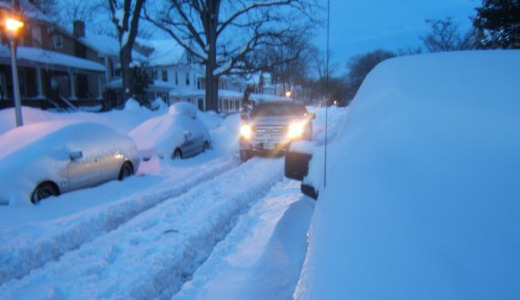
Some Republicans are having great fun laughing about the recent snowstorms on the East Coast. They pretend that global warming would, if real, somehow eliminate winter. Therefore, the fact that we still have winter must mean that global warming isn’t real. Somehow, “Snowmageddon” in DC trumps lack of snow in Vancouver, B.C., for the Winter Olympics, at least as far as U.S. political theater. (They’re having to truck in snow for Olympic events!)
Senator Jim DeMint, R-S.C., he of “let’s make health care Obama’s Waterloo,” tweeted that “it’s going to keep snowing in DC until Al Gore cries ‘uncle.'” Another right-wing loon, Senator James Inhofe of Oklahoma, had some aides construct an igloo and label it “Al Gore’s Home.” Even some Democratic senators are claiming that the snowstorms in DC make it much less likely that any climate change legislation will pass this year, because it makes it more difficult to argue that global warming is an imminent danger.
This blizzard of nonsense has everything to do with right-wing campaigns and nothing to do with reality. Climate scientists, and climate change campaigners, never claimed that global warming would somehow magically eliminate winter instantaneously. The world’s global average temperature over a year continues to rise, but we will also continue to have seasons.
Global warming doesn’t mean that it will be hot everywhere all the time, right now. Winter won’t disappear. There will still be snowstorms. There will still be icy conditions on our roadways some of the time.
One trick the climate change deniers use is to take the long-term projections of climate scientists, their most dire warnings, and pretend that if the worst doesn’t happen right now, this instant, the whole idea must be false.
What the scientists are telling us, rather, is that we are on a path to catastrophe in the long run. If all the ice in Greenland melts, sea levels will rise more than 20 feet. No one is claiming that sea levels will rise that much this year, or next, or even for many decades. But, if we don’t act now, we turn the dire predictions into self-fulfilling prophecies. If we don’t stop the long-term buildup of greenhouse gasses in the atmosphere, we will accelerate the melting of Greenland. The fact that sea levels aren’t swamping Florida this week neither proves nor disproves these predictions.
There is another bit of phony reasoning hidden in the deniers’ frivolity and sarcasm. Even though snow is certainly identified with winter, more snow does not disprove global warming. With warmer climates, there is more evaporation, putting more potential precipitation into the clouds, which will come down as snow during winter. More snow is actually more proof of global warming, as counter-intuitive as that sounds. Global climate change theory predicts many more extreme weather of many kinds, from more devastating hurricanes to more intense floods and droughts, to more just plain “weird weather” events.
Global climate change is happening on a much faster timeline than in the past, if you look at geologic eras. But faster doesn’t mean instantly. Rather than the ice sheets melting over thousands of years, it will likely be a few hundred, unless we act now. Just because a threat may take decades to fully manifest itself, that doesn’t mean that the threat isn’t immanent.
Greenhouse gasses accumulate in the atmosphere. Every additional ton of carbon dioxide that goes up stays there for about a hundred years. So unless we stop adding to that accumulation, we are adding to the problem, and making it more difficult to solve in the future. If we wait until the storm surges are lapping Wall Street in lower Manhattan, it will be too late to solve the problem, for two reasons.
One, because so much global warming pollution will have accumulated that we can’t reduce it fast enough to stop the problems from getting worse. Second, because once it gets warm enough, we will pass several tipping points that will overwhelm anything humanity does to slow global warming.
For example, as the ice melts in the Arctic (already happening at a fast pace), less ice means less of the sun’s rays are reflected back into space and more are absorbed by the darker ocean that is now exposed. This speeds up warming in the Arctic, already happening much faster than in the continental U.S. As it gets warmer, the permafrost which covers much of the far north will melt (as is already happening in Alaska-just look at pictures of collapsing houses and telephone poles.). That permafrost contains many millions of tons of frozen greenhouse gases including carbon dioxide and methane, which are released as the melting occurs. If we get to the point where the permafrost is melting much more rapidly, so much greenhouse gas will be emitted that human efforts will be dwarfed, no matter how radically we reduce our emissions.
We have to turn around before we reach that point. That’s why we have to act now, so we don’t create a crisis which is unsolvable on a human timeframe.
So even if there is lots of snow, we still have to act sooner rather than later.
Photo: Street scene in Baltimore this week. The Feb. 10 blizzard broke the city’s snowfall record, dumping 18-20 inches on top of the 26 inches that fell Feb. 5-6. (PW/Tim Wheeler)










